The Oxford Nursing Home proposal for a zoning change (ULURP) in Red Hook received a setback at the December 3 meeting of Community Board 6’s (CB6) landmark/land use committee. A motion against the plan was passed 11-5, with one abstention. On December 9th, the full CB6 board will meet at Borough Hall for a final vote. It then travels to Brooklyn’s Borough President for his opinion, and then on to the City Council for a final hearing. Red Hook’s councilman, Carlos Menchaca, has gone on record as being against the proposal because of the risks in building a nursing home in a flood zone.

Oxford Nursing Home is a family owned, for-profit nursing home that is currently located in Fort Greene in a 103 year-old building that was once an Elks Club. The NYS Department of Health (DOH) determined the facility to be outmoded and owner Barry Braunstein purchased land in Red Hook in 2003 with plans to build a brand new, state-of-the art nursing home. The promise of a new home allowed him to keep the Fort Greene location open.
The CB6 meeting was held in the auditorium of PS 27, and drew over 100 people, including residents, CB6 members and invited guests who came to speak on behalf of Oxford. The meeting began with a moment of silence for longtime community leader Bette Stolz, who passed away suddenly last month. Oxford then was given the floor for their presentation.
The presentation was led by Nora Martins, a lawyer with the firm Davidoff, Citron and Hutcher, LLC, representing Oxford. Owner Bergman and members of his family and staff sat on the right side of the auditorium, listening.
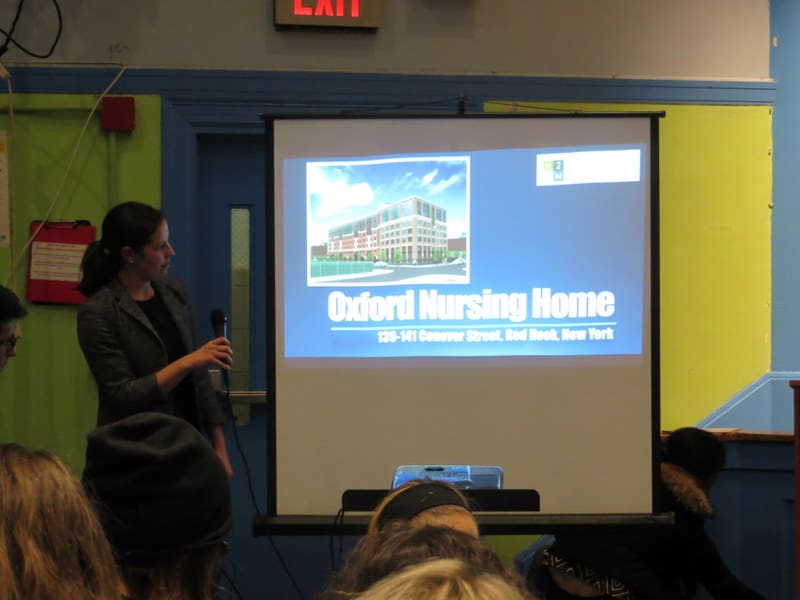
Martins began by recounting the history of Oxford’s land purchase in Red Hook. They bought almost the whole block of land, bordered by Van Brunt, Sullivan, Conover and King Streets, in 2003. They have rented out the property on a short term basis to a welding company and as truck and bus storage since then.
In 2006, NYC created a new zoning designation called Industrial Business Zones (IBZ) which strengthened manufacturing zone in 16 designated areas. A part of Red Hook, which included the Oxford property, was made an IBZ. This made it improbable that a zoning change allowing a nursing home facility would be approved. In 2009, Oxford was granted a Certificate of Need by the DOH, approving their plans to build a $65 million nursing home in Red Hook. In 2013, the city modified some of the IBZ zones. Both Oxford and Pioneer Works asked to be let out of the IBZ, and both applications were granted.
This set the stage for the present ULURP application, which was the topic of the Land Use meeting. A ULURP is a procedure in which zoning changes are considered and either approved or rejected. The process begins at the NYC Dept of City Planning (DCP), where the application is first filed. Once approved, it begins a hearing process that starts at the local community board, then goes to the Borough President and then back to DCP. City Planning holds public hearings and issues it’s recommendation, either to approve or deny.
If approved, the application goes to the NY City Council for consideration. In most, but not all cases, the Council will defer to the judgment of the local councilmember. A majority vote of the council is needed for approval. If approved, the mayor is allowed a veto, which may then be overridden by a 2/3rd vote of the city council.
Even though the Oxford location was taken out of the IBZ, a zoning change from manufacturing to commercial/residential is still required, hence their ULURP application, which was approved by DCP on November 30.
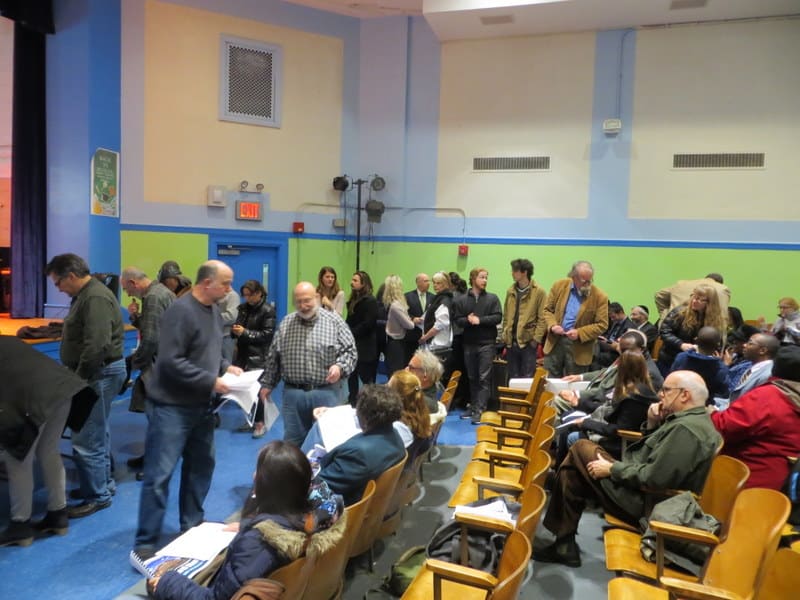
Martin introduced some changes to their original plan, which was presented last summer. Based upon community input, they lowered the height by one story and changed the design to try and make it more like the surrounding buildings. In addition to the 200 bed facility, they will be building a separate healthcare facility on the property and she mentioned that they are in discussion with Doctor’s On Call, who would provide urgent care, including an MRI service, but not an emergency room.
A web search of Doctor’s On Call reveal that they are a provider of medical care for the homebound, so this would be their first actual brick and mortar facility.
Addressing height issues, Martin said that the building would be seven stories with an additional story set back. It’s heighest point would reach 89 feet. She explained that because of the possibility of floods, the first floor is designed to begin at 15 feet above the ground, and that unlike other nursing homes, there would be no basement.
Provision would be made for 53 off-street parking spaces for staff and visitors, and an off street loading zone for deliveries. Generators with enough fuel to provide electricity for 72 hours would be on-site, and in the event of patient evacuations, transfer agreements with other nursing homes are already in place.
At this point, the floor was opened up to the public for statements both for and against Oxford’s proposal. Speakers in favor of the facility tended to be residents of the Red Hook Houses, who looked forward to the possibility of local jobs and the availability of eldercare. Supporters also included a representative of the Brooklyn Chamber of Commerce and local 1199, whose union represents current workers at the Fort Greene facility. Speakers against tended to be homeowners who objected to what they consider an out-of-scale and inappropriate change to historic Red Hook.

The first speaker with Catherine Despont, who appeared for Pioneer Works as owner Dustin Yellin was out of town. She began by citing the unsuitability of placing a medical facility in a flood zone. She also noted the impact of such a facility placed in the middle of a developing cultural area, of which Pioneer Works is a major player. She wondered how emergency vehicles would interact with tourists who have made Pioneer Works a destination location. She ended with a poignant statement of the importance of sunlight to the artistic ethos of a building devoted to the arts, a 37 foot building that would end up in the shadow of a new, much taller neighbor.
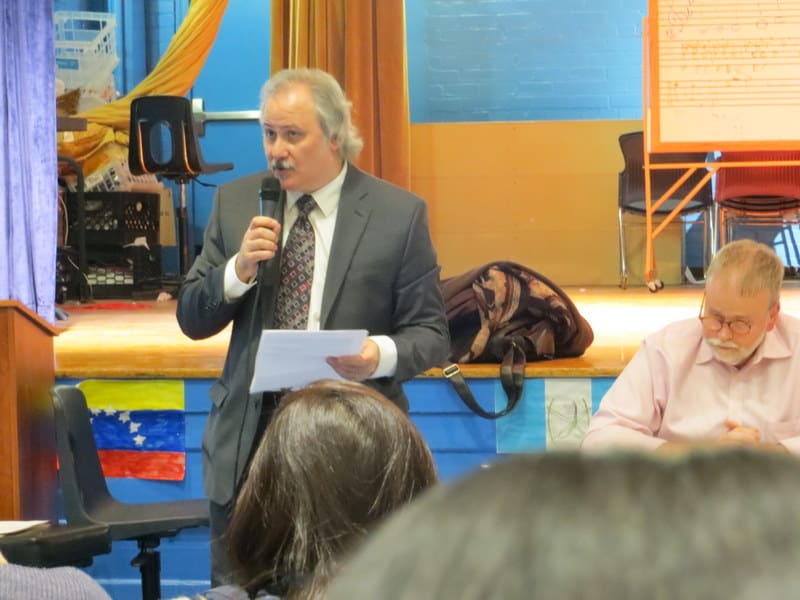
Rick Russo, Sr. Vice President and COO of the Brooklyn Chamber of Commerce spoke of the jobs that the nursing home would bring to Red Hook. He called it an anchor for burgeoning commercial activity in Red Hook. He lauded the proposed landscaping and planting of trees that are part of the proposal. He acknowledged that height was a concern but noted that the architect lopped off a floor in response.
Lisa Serrano, a homeowner adjacent to the property spoke of the danger to residents of increased traffic – a concern shared by many. She condemned the loss of views that the tall building would create. She questioned the safety of diesel gas storage and wondered how ambulances would navigate the already overcrowded and narrow cobblestoned streets of Red Hook. She called the morning rush hour “vicious.”
Steven Kondaks, resident and member of the NY Rising Committee, announced that FEMA is against this. He said that the community is not against nursing homes, but urged them to find a better place, telling them that they could sell their current property for a lot of money. “We have no hard feelings,” he said.
Lillie Marshall, president of the Red Hook West Tenant’s Association, told of the many changes she has seen in Red Hook through her many years in the neighborhood. “Adapt to change. Help us out with this. We need this service,” she said, urging approval of the Oxford proposal.
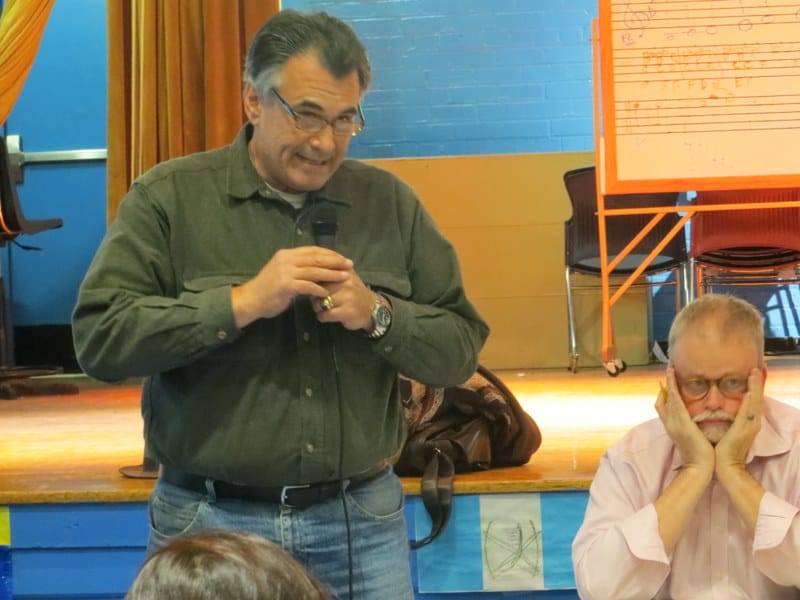
Local businessman Jim Tampakas, also a member of the NY Rising Committee, which helped prepare a flood resiliency program, said that the emergency plan already in place for Red Hook would have to undergo major alterations with the addition of 200 elderly people. He challenged Oxford’s contention that the lot as is remains underutilized, saying that as owners of the lot since 2003 they are responsible for its lack of use.
A representative from Local 1199 took the floor to praise Oxford as an employer. He said they provide good jobs, good care, and believe in social justice. He called them an honest employer.
A homeowner from Richards Street took the floor calling the project a “behemoth.” “A four story building would be acceptable,” she said. She read the following statement, taken from a letter of opposition written by NY Rising, after a private Oxford presentation.
“Red Hook is often described as an “open sky” landscape. View corridors are critical to the experience. Such height across the swath of an entire block would have a serious impact on the skyline of Red Hook. This is a very serious issue.
If such consideration is given, a door will be opened for much greater density and height exceptions, transforming Red Hook’s essential historic character, an asset that should be strenuously protected. 4. Red Hook is currently experiencing the return of a thriving light-manufacturing district in addition to a robust art and artisanal community that draws tourism and like-minded enterprises.
City Planning is conducting studies on the revitalization of M-zones in our area and how to assist in supporting these. Those who choose to locate here want to be part of the resurgence of this historic place. Altering the historic open sky nature of Red Hook would detract from its appeal to other light-manufacturing business and go against the essential nature and appeal of this community. Through careful planning and with resiliency front and center, this community is on a positive and sustainable trajectory. Any proposal that undermines the recovery and basic cultural value of this community must be opposed. ”
Roslyn Lee, representing seniors in the Red Hook Houses, remembered that the community made room for IKEA, Fairway and the Water Taxi. “How about something for the seniors?” she asked.
Lou Sones, former CB6 member and co-founder of Groups Against Garbage (GAGS), bemoaned a divided Red Hook on this issue, and said that other sites are available.
Mary Kyle, owner of a neighborhood liquor store, spoke in a booming voice against the proposal saying that she is not against a nursing home in the area. Her objection was to the size and design, saying it is like having something alien being “dropped on a lot.”
Marshall Sohne, a longtime Carroll Gardens resident and real estate developer, objected to the zoning plan, calling it close to spot zoning. “It has no light or air or plan for transportation. It will change the character of the neighborhood. This is a private rezoning. If there will be a rezoning, let it be part of some sensible neighborhood plannning,” he said, to applause.
Robin Goeman, a Van Brunt Street resident and elder law attorney, pointed out the problems faced by nursing homes in the Rockaways and Coney Island relocating residents during Sandy. She questioned the longevity of a new nursing home, saying that the proposed rezoning would open the door to luxury condos were the facility one day fail.
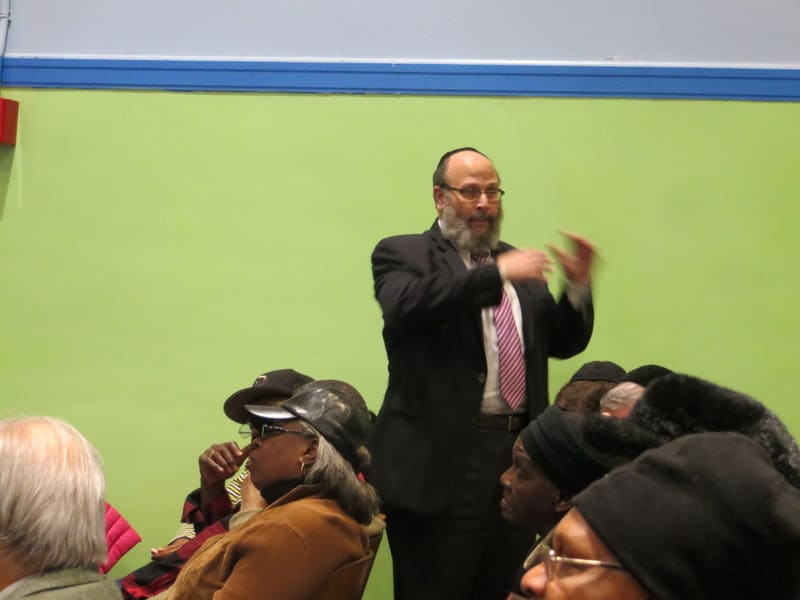
After some more back and forth, Oxford owner Barry Braunstein got up from his seat to make a statement. “This is what I do!” he explained passionately, responding to questions as to the permanence of the facility. “I plan to do this until I need a nursing home myself!”
The meeting, which began around 6 pm, was by now almost two hours old, and Chair Peter Fleming turned to the members of the committee, sitting in the first two rows, and let them ask questions directly to Martin and the other Oxford representatives, in preparation for their vote. After a while it seemed evident that they would vote against the ULURP plan. However, Mark Shames, committee member and Star-Revue columnist, spoke in favor, despite having had some bad personal experiences with the Fort Greene nursing home. “Despite the fact that they suck, we need more and more senior facilities in NY. I understand all the concerns, but losing 200 beds in Brooklyn would be terrible. This needs to get done.”
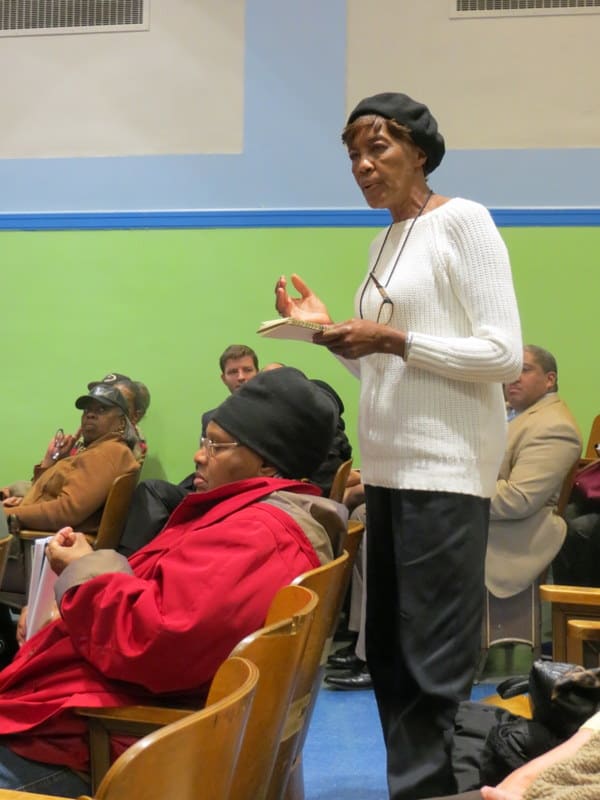









5 Comments
How about the site along Columbia st
Where are under utilized docks are located.
Near Atlantic ave. The Brooklyn parks can come further down connecting Red Hook to the park across Atlantic ave. The home can then place their facility there. Maybe the company can make a trade.
The Pioneer property, for the property there.
It’s better for vehicles, you have the BQE,and
Atlantic Ave for emergency evacuation. Thus
preserving the culture of RedHook.
In my opinion.
Why is site telling me I already said this?
Censorship much,
I
How about the site along Columbia st
Where are under utilized docks are located.
Near Atlantic ave. The Brooklyn parks can come further down connecting Red Hook to the park across Atlantic ave. The home can then place their facility there. Maybe the company can make a trade.
The Pioneer property, for the property there.
It’s better for vehicles, you have the BQE,and
Atlantic Ave for emergency evacuation. Thus
preserving the culture of RedHook.
Actually, I was thinking along similar lines. I would make the trade for the park that’s by the tunnel, Harold Ickes park, on Hamilton and Van Brunt. I rarely see anybody using that park. Put the nursing home there, and put a park further up into the Hook.
Pingback: CB 6 reverses committee decision on nursing home, by George Fiala - Red Hook Star-Revue
As a past caregiver to an elderly patient, I can say besides the ridiculous placing of a nursing home in a flood Zone, this is an awful location for elderly people for many reasons. The elderly need a place to walk, feel secure, quiet, and at peace with their surroundings. None of these requirements exists in this space!!
Also, The facility next door has many events at night that enhance Red hook and the culture it has evolved .These events would interrupt precious sleep and cause confusion and lead to agitation. Not to mention the danger in having to evacuate in disasters!!
Please find another, more suitable site for this much needed facility.
This site is completely inappropriate!!!